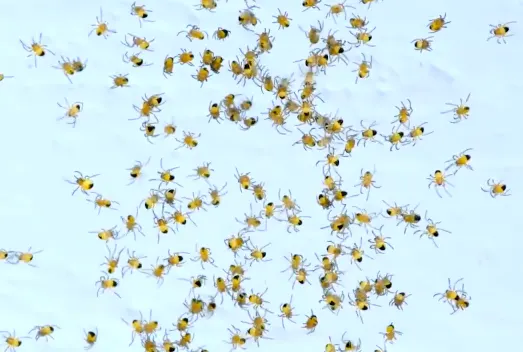
Spider baby boom observed in the Arctic as temperatures warm
This study provides the first evidence of an Arctic spider species being able to produce two clutches, a behaviour that was typically only seen in warmer latitudes.
Scientists are observing changes in Arctic food chains as temperatures warm and a recent study has found that the earlier spring snowmelt is causing a spider baby boom.
Animals in the Arctic are highly sensitive to even the slightest change in temperature and the shorter winter seasons are influencing wolf spiders’ behaviours. Data collected from 1996 to 2014 found that wolf spiders were laying a second clutch of eggs as opposed to just one, a phenomenon that occurs in warmer and more temperate latitudes but has never been observed in the Arctic.
During the years with earlier snowmelt, the spiders produced their first clutches sooner and then produced abnormally large second clutches later on in the season. The data collected over the 18 years in this study shows the unsettling correlation between warming temperatures and more spider eggs.
The researchers say that their study is the first evidence for Arctic invertebrates producing additional clutches in response to the warming climate. It was previously assumed that the constraints of the low temperatures and extremely short Arctic growing seasons would only allow wolf spiders to lay one clutch of offspring.
In addition to the climate becoming more viable for reproduction, the researchers found that longer growing seasons are related to increasing female body size in wolf spiders. Previous studies have found that earlier snowmelt is related to an increase in female body size, but this study says that there was no indication that larger females are more likely to produce a second clutch than smaller females.

A wolf spider photographed in Alaska (2008). Credit: D. Sikes/ Wikimedia Commons. CC BY-SA 2.0
The size of the clutches that larger females produced were not significantly different than those from smaller females, which the researchers say indicates that the second clutch production is associated with the timing of the snowmelt and not a result of females having access to more food resources during the longer growing season.
While one might not immediately think of spiders as the species highest on the food chain, wolf spiders in Greenland are a top predator and widely distributed across the tundra ecosystem. The growth of the wolf spider population will result in a higher demand for food resources, which could shrink prey populations, especially if their population size does not have the same response to earlier snowmelt.
Only one site in northeastern Greenland was used for collecting spider data in this study, but based on the researchers’ robust findings, they say that it is likely other wolf spider species are producing second clutches at lower Arctic and boreal latitudes, such as those in Eurasia, Alaska and Canada.
The study did not observe significant changes in the wolf spiders’ population size and they say this could possibly be due to differing viability of eggs from separate clutches. However, one thing is for sure, spiders in the Arctic are laying more eggs and scientists are certain that changes in biodiversity will continue as the North continues to melt.












